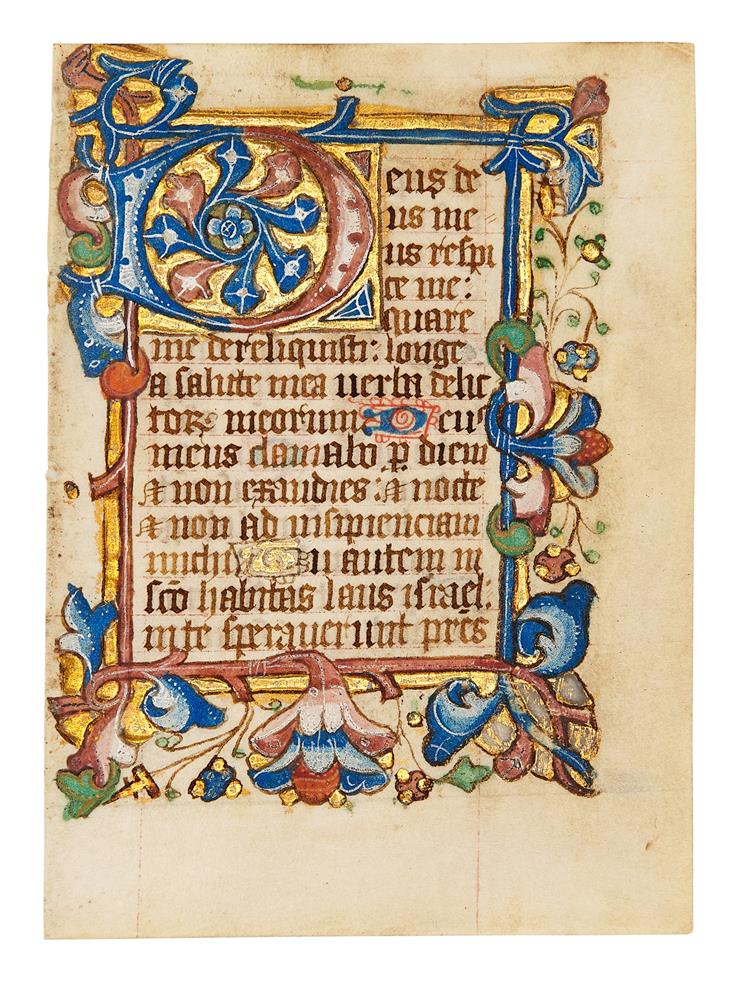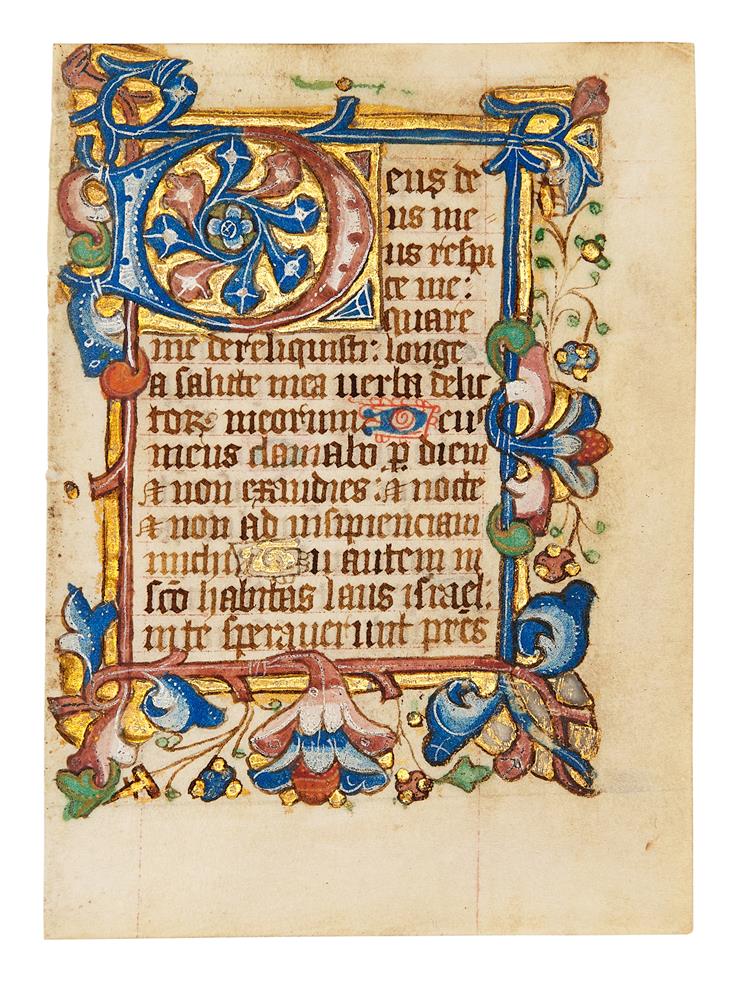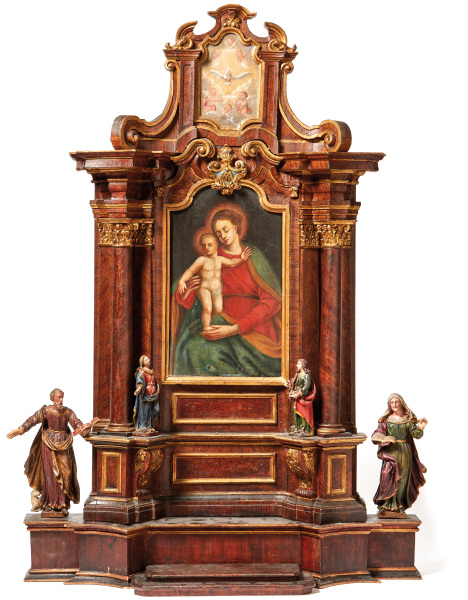ST. BIRGITTA OF SWEDEN (1303-1373). Rule of the Bridgettine Order, in Latin. MANUSCRIPT ON VELLUM. [Italy, 17th century] 212 x 158mm, 34 leaves, including two final blanks, COMPLETE, collation: 1 4 2 6 3-8 4 , catchwords on every verso, 20 lines, single column, vertical margins ruled in lead on flesh sides only, justification: 175 x 197mm, written in black ink in a calligraphic slanted humanistic (ff.1-29) or italic (ff. 29-32v) hand, rubrics in red, 33 two-line calligraphic initials in gold, 2 in blue, smaller caligraphic initials in blue or red, three lines of display script in gold, red and black on f.1, notary's mark on f.32v. Binding of limp vellum. PROVENANCE: Di D. Benedetto Bigoi (?) ex Canonico Regulari santissimo Salvatore (front pastedown). TEXT Regula sancti Salvatoris (ff.1-29v); document of Nicholas, bishop of Linköping, 5 August 1445 (ff.29-31); document of Petrus Suenonis, notary of the diocese of Linköping (ff.31-32v, ff.33-34v blank). The Bridgettine Order, founded by St. Birgitta of Sweden, was the last religious order for women to be established in the Middle Ages. To solve the perennial problem of providing spiritual and temporal care for enclosed nuns, Birgitta drew on the earlier medieval model of the double monastery. Each Bridgettine community was to consist of a group of up to sixty cloistered women and a smaller number of male clerics sharing a church but strictly segregated in their living quarters and daily routines, all under the direction of the abbess. According to Birgitta, the rule of the order was dictated to her by Christ in a vision, hence the common designation of both the rule and the order as sancti Salvatoris . Although Birgitta devoted much of her later life to attempts to have the rule approved by the papacy, this was not accomplished until after her death. In 1383, Pope Urban VI authorized the use of a substantially modified version of the text, to be observed as constitutions in conjunction with the rule of St. Augustine. In the course of the 15th century, the order spread throughout northern Europe and to Italy and Spain. Its two most famous foundations were the motherhouse of Vadstena in Sweden and Syon Abbey in England. The present manuscript represents the version of the rule dictated to Birgitta, rather than the papally approved version. It was evidently made from a copy produced in 1445, which was itself taken from the official copy of Birgitta's writings preserved in a precious and lavishly ornamented codex at Vadstena. The two documents appended to the 1445 copy and recopied in this codex give valuable evidence as to the appearance of the source manuscript, the characteristics of the 1445 copy, and the process by which the accuracy of such a copy was certified. The text of the present manuscript is particularly close to the text of the rule as it was first published in Birgitta's Revelationes (Lübeck: B.Ghotan, 1492). Since that edition was published for Vadstena, undoubtedly from materials provided by the monastery, these two copies of the rule, the editio princeps and this manuscript, are probably derived from the same authoritative source. The present manuscript was not known to the modern critical edition of the Bridgettine Rule (Sancta Birgitta, Opera minora I: Regula Salvatoris , ed. Sten Eklund, Stockholm, 1975), although this edition lists other 17th-century copies of the text.
ST. BIRGITTA OF SWEDEN (1303-1373). Rule of the Bridgettine Order, in Latin. MANUSCRIPT ON VELLUM. [Italy, 17th century] 212 x 158mm, 34 leaves, including two final blanks, COMPLETE, collation: 1 4 2 6 3-8 4 , catchwords on every verso, 20 lines, single column, vertical margins ruled in lead on flesh sides only, justification: 175 x 197mm, written in black ink in a calligraphic slanted humanistic (ff.1-29) or italic (ff. 29-32v) hand, rubrics in red, 33 two-line calligraphic initials in gold, 2 in blue, smaller caligraphic initials in blue or red, three lines of display script in gold, red and black on f.1, notary's mark on f.32v. Binding of limp vellum. PROVENANCE: Di D. Benedetto Bigoi (?) ex Canonico Regulari santissimo Salvatore (front pastedown). TEXT Regula sancti Salvatoris (ff.1-29v); document of Nicholas, bishop of Linköping, 5 August 1445 (ff.29-31); document of Petrus Suenonis, notary of the diocese of Linköping (ff.31-32v, ff.33-34v blank). The Bridgettine Order, founded by St. Birgitta of Sweden, was the last religious order for women to be established in the Middle Ages. To solve the perennial problem of providing spiritual and temporal care for enclosed nuns, Birgitta drew on the earlier medieval model of the double monastery. Each Bridgettine community was to consist of a group of up to sixty cloistered women and a smaller number of male clerics sharing a church but strictly segregated in their living quarters and daily routines, all under the direction of the abbess. According to Birgitta, the rule of the order was dictated to her by Christ in a vision, hence the common designation of both the rule and the order as sancti Salvatoris . Although Birgitta devoted much of her later life to attempts to have the rule approved by the papacy, this was not accomplished until after her death. In 1383, Pope Urban VI authorized the use of a substantially modified version of the text, to be observed as constitutions in conjunction with the rule of St. Augustine. In the course of the 15th century, the order spread throughout northern Europe and to Italy and Spain. Its two most famous foundations were the motherhouse of Vadstena in Sweden and Syon Abbey in England. The present manuscript represents the version of the rule dictated to Birgitta, rather than the papally approved version. It was evidently made from a copy produced in 1445, which was itself taken from the official copy of Birgitta's writings preserved in a precious and lavishly ornamented codex at Vadstena. The two documents appended to the 1445 copy and recopied in this codex give valuable evidence as to the appearance of the source manuscript, the characteristics of the 1445 copy, and the process by which the accuracy of such a copy was certified. The text of the present manuscript is particularly close to the text of the rule as it was first published in Birgitta's Revelationes (Lübeck: B.Ghotan, 1492). Since that edition was published for Vadstena, undoubtedly from materials provided by the monastery, these two copies of the rule, the editio princeps and this manuscript, are probably derived from the same authoritative source. The present manuscript was not known to the modern critical edition of the Bridgettine Rule (Sancta Birgitta, Opera minora I: Regula Salvatoris , ed. Sten Eklund, Stockholm, 1975), although this edition lists other 17th-century copies of the text.




.jpg)




.jpg)

.jpg)


Try LotSearch and its premium features for 7 days - without any costs!
Be notified automatically about new items in upcoming auctions.
Create an alert